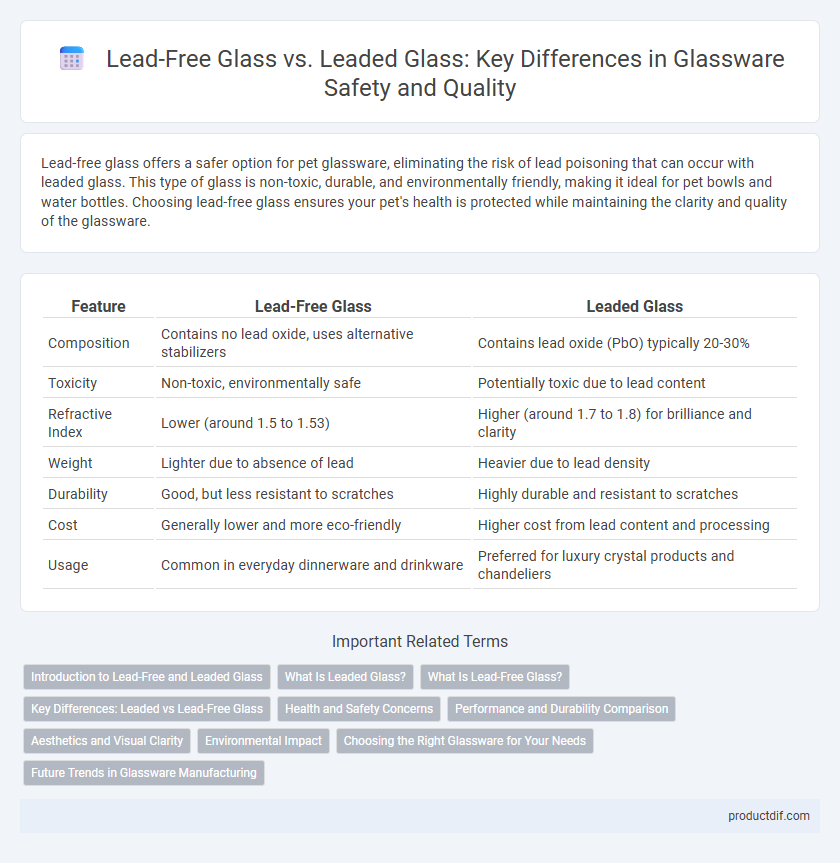Lead-free glass offers a safer option for pet glassware, eliminating the risk of lead poisoning that can occur with leaded glass. This type of glass is non-toxic, durable, and environmentally friendly, making it ideal for pet bowls and water bottles. Choosing lead-free glass ensures your pet's health is protected while maintaining the clarity and quality of the glassware.
Table of Comparison
| Feature | Lead-Free Glass | Leaded Glass |
|---|---|---|
| Composition | Contains no lead oxide, uses alternative stabilizers | Contains lead oxide (PbO) typically 20-30% |
| Toxicity | Non-toxic, environmentally safe | Potentially toxic due to lead content |
| Refractive Index | Lower (around 1.5 to 1.53) | Higher (around 1.7 to 1.8) for brilliance and clarity |
| Weight | Lighter due to absence of lead | Heavier due to lead density |
| Durability | Good, but less resistant to scratches | Highly durable and resistant to scratches |
| Cost | Generally lower and more eco-friendly | Higher cost from lead content and processing |
| Usage | Common in everyday dinnerware and drinkware | Preferred for luxury crystal products and chandeliers |
Introduction to Lead-Free and Leaded Glass
Lead-free glass eliminates toxic lead oxide from its composition, enhancing safety and environmental compliance without compromising clarity and durability, making it ideal for everyday use and food-related applications. Leaded glass contains lead oxide, which increases refractive index and brilliance, commonly used in decorative items and optical instruments due to its superior weight and appearance. Understanding the composition differences helps consumers choose safer alternatives while preserving aesthetic and functional qualities in glassware.
What Is Leaded Glass?
Leaded glass contains lead oxide, which enhances its density, brilliance, and refractive properties, making it popular for decorative and high-quality glassware such as crystal vases and fine drinkware. The inclusion of lead increases the glass's weight and softness, allowing for intricate cutting and engraving while producing a distinct sparkle. Compared to lead-free alternatives, leaded glass poses health concerns due to potential lead leaching, especially when used with food or beverages.
What Is Lead-Free Glass?
Lead-free glass is a type of glass manufactured without the addition of lead oxide, making it a safer and more environmentally friendly alternative to leaded glass. This glass offers high clarity and durability while reducing health risks associated with lead exposure in everyday use, especially in drinkware and food containers. Commonly used in kitchenware, lead-free glass meets stringent safety standards and retains excellent thermal and chemical resistance.
Key Differences: Leaded vs Lead-Free Glass
Lead-free glass contains no lead oxide, making it safer for food and beverage use due to its non-toxic nature, whereas leaded glass incorporates lead oxide, enhancing its refractive index and brilliance. The higher density of leaded glass results in exceptional clarity and weight, commonly preferred for luxury glassware and optical instruments. In contrast, lead-free glass prioritizes environmental safety and regulatory compliance, offering a lighter, more durable alternative suitable for everyday glassware applications.
Health and Safety Concerns
Lead-free glass eliminates the health risks associated with lead leaching into food and beverages, making it a safer option for everyday use. Leaded glass contains lead oxide, which can pose serious health hazards such as neurological damage and kidney problems when ingested over time. Choosing lead-free glassware ensures compliance with safety standards and reduces exposure to toxic substances.
Performance and Durability Comparison
Lead-free glass offers superior chemical resistance and enhanced durability compared to leaded glass, making it ideal for everyday use and frequent washing. Leaded glass, while prized for its brilliance and weight, is more prone to etching and damage over time, especially under harsh cleaning conditions. The absence of lead in lead-free glass also ensures safer performance in applications involving food and beverages without compromising aesthetic quality.
Aesthetics and Visual Clarity
Lead-free glass offers superior visual clarity due to its lower refractive index, resulting in a more transparent and less yellowish appearance compared to leaded glass. Leaded glass, although prized for its brilliance and weight, often exhibits a slight greenish tint that can affect color fidelity in decorative pieces. The choice between these materials impacts the overall aesthetic appeal, with lead-free glass providing a cleaner, more modern look, while leaded glass delivers traditional sparkle and depth.
Environmental Impact
Lead-free glass significantly reduces environmental toxicity by eliminating the release of hazardous lead compounds during manufacturing and disposal. Unlike leaded glass, which poses serious risks of soil and water contamination, lead-free alternatives offer a safer lifecycle with diminished ecological footprint. Recycling processes for lead-free glass are more environmentally sustainable, promoting safer reuse and reducing hazardous waste accumulation.
Choosing the Right Glassware for Your Needs
Selecting the right glassware involves weighing the benefits of lead-free glass, which offers enhanced safety and environmental friendliness, against leaded glass, known for its brilliance and weight. Lead-free glassware is ideal for everyday use and households with children, reducing health risks associated with lead exposure. Choose leaded glass for formal occasions or display purposes, where its clarity and elegance add sophistication without frequent handling concerns.
Future Trends in Glassware Manufacturing
Future trends in glassware manufacturing emphasize the shift towards lead-free glass due to increasing health and environmental regulations restricting the use of leaded glass. Innovations in eco-friendly materials and advanced production techniques enhance the durability and clarity of lead-free alternatives, meeting consumer demand for safer, sustainable glass products. Manufacturers are investing in research to optimize lead-free compositions, driving a market trend focused on sustainable luxury and regulatory compliance in glassware.
Lead-Free Glass vs Leaded Glass Infographic

 productdif.com
productdif.com